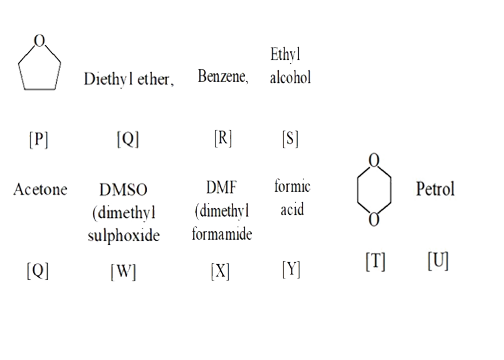Bromination of phenol in non-polar solvent forms __________
o-bromophenol
p-bromophenol
mixture of o and p-bromophenol
m-bromophenol
The correct Answer is:C
To solve the question regarding the bromination of phenol in a non-polar solvent, we will follow these steps:
Step 1: Understand the structure of phenol
Phenol (C6H5OH) consists of a benzene ring bonded to a hydroxyl group (-OH). The presence of the hydroxyl group makes the benzene ring more reactive towards electrophilic substitution reactions, such as bromination.
Hint: Recall that the -OH group is an electron-donating group, which influences the reactivity of the aromatic ring.
Step 2: Identify the directing effects of the -OH group
The hydroxyl group is an ortho-para directing group due to its ability to donate electron density to the benzene ring through resonance. This means that during bromination, the bromine will preferentially add to the ortho (adjacent) and para (opposite) positions relative to the -OH group.
Hint: Remember that ortho and para positions are favored for substitution when an activating group is present.
Step 3: Consider the solvent used in the reaction
In this case, the bromination of phenol is carried out in a non-polar solvent, such as carbon tetrachloride (CCl4). Non-polar solvents do not stabilize ionic intermediates as well as polar solvents. However, the ortho and para positions are still favored due to the resonance stabilization provided by the -OH group.
Hint: Think about how the choice of solvent can influence the stability of intermediates during a reaction.
Step 4: Predict the products of bromination
When bromine (Br2) is added to phenol in a non-polar solvent, the reaction will yield a mixture of ortho-bromophenol and para-bromophenol. The meta-bromophenol is not formed because the -OH group directs the bromination to the ortho and para positions.
Hint: Consider the positions where bromine can attach to the benzene ring based on the activating effects of the -OH group.
Step 5: Conclusion
Thus, the bromination of phenol in a non-polar solvent forms a mixture of ortho-bromophenol and para-bromophenol.
Final Answer: The bromination of phenol in a non-polar solvent forms a mixture of ortho-bromophenol and para-bromophenol.
Phenol (C6H5OH) consists of a benzene ring bonded to a hydroxyl group (-OH). The presence of the hydroxyl group makes the benzene ring more reactive towards electrophilic substitution reactions, such as bromination.
The hydroxyl group is an ortho-para directing group due to its ability to donate electron density to the benzene ring through resonance. This means that during bromination, the bromine will preferentially add to the ortho (adjacent) and para (opposite) positions relative to the -OH group.
In this case, the bromination of phenol is carried out in a non-polar solvent, such as carbon tetrachloride (CCl4). Non-polar solvents do not stabilize ionic intermediates as well as polar solvents. However, the ortho and para positions are still favored due to the resonance stabilization provided by the -OH group.
When bromine (Br2) is added to phenol in a non-polar solvent, the reaction will yield a mixture of ortho-bromophenol and para-bromophenol. The meta-bromophenol is not formed because the -OH group directs the bromination to the ortho and para positions.
Thus, the bromination of phenol in a non-polar solvent forms a mixture of ortho-bromophenol and para-bromophenol.
Topper's Solved these Questions
- BOOK - TARGET PUBLICATIONCHAPTER - ALCOHOLS, PHENOLS AND ETHERS EXERCISE - CRITICAL THINKING107videos
ALCOHOLS, PHENOLS AND ETHERS
- BOOK - TARGET PUBLICATIONCHAPTER - ALCOHOLS, PHENOLS AND ETHERS EXERCISE - COMPETITIVE THINKING88videos
ALCOHOLS, PHENOLS AND ETHERS
- BOOK - TARGET PUBLICATIONCHAPTER - ALDEHYDES, KETONES AND CARBOXYLIC ACIDSEXERCISE - EVALUATION TEST19videos
ALDEHYDES, KETONES AND CARBOXYLIC ACIDS
Similar Questions
Knowledge Check
- Question 1 - Select One
The crown-guest complex is called an inclusion compound. The crown ether allows the inorganic salt to dissolve in non-polar solvents. KMnO4 forms a complex with crown ether. In this complex, the host is…. and the guest is…… .
AK⊕ and crown etherBCrown ether and K⊕CMnO−4 and crown etherDCrown ether and MnO−4 - Question 2 - Select One
Best nucleophile in polar protic solvent is
AF−BCl−CBr−DI− - Question 3 - Select One
Bromination of phenol , will NOT give __________.
A B
B C
C D
D
How many of the following are polar aprotic solvents?
 View Solution
View SolutionBest nucleophile in polar aprotic solvent is
View SolutionWhich contain both polar and non-polar bonds ?
View SolutionIn bromination of phenol, o-Bromophenol is minor product due to ___________.
View SolutionWhich contain both polar and non-polar bonds?
View Solution

